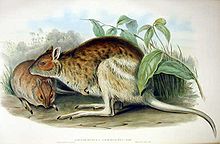Spectacled hare-wallaby
| Spectacled hare-wallaby[1] Temporal range: Recent[2]
| |
|---|---|

| |
| Plate 58 of Mammals of Australia Vol. II | |
| Scientific classification | |
| Domain: | Eukaryota |
| Kingdom: | Animalia |
| Phylum: | Chordata |
| Class: | Mammalia |
| Infraclass: | Marsupialia |
| Order: | Diprotodontia |
| Family: | Macropodidae |
| Genus: | Lagorchestes |
| Species: | L. conspicillatus
|
| Binomial name | |
| Lagorchestes conspicillatus Gould, 1842
| |
| Subspecies | |

| |
| Spectacled hare-wallaby range | |
The spectacled hare-wallaby (Lagorchestes conspicillatus) is a species of
Barrow Island, while the mainland type is widespread, though in decline, across northern regions of the country.[3]
Description
A species of Lagorchestes, hare-wallaby are small members of the family Macropodidae. The spectacled hare-wallaby is found across northern Australia in tropical
spinifex habitats. It can be found from Queensland to Western Australia. In 1997, it was discovered in the savanna country of southwest Papua New Guinea, in the upper Bensbach River area.[4] It is a solitary, nocturnal herbivore, and is considerably larger than its relatives. It is coloured grey-brown with golden tips and an orange circle around its eye, from which it gets its name.[5] It builds its nests among the tough vegetation. When disturbed it hops off in a zigzag manner. The young are produced singly at any time of the year and become sexually mature at about a year old.[6]
Naming and taxonomy

The species was first described by
rodent genus
.
Threat and status
The species was reviewed on the
Red List
(2008) as having the conservation status least concern.
The subspecies L. conspicillatus conspicillatus is restricted to Barrow Island, Western Australia, but was once found throughout the Montebello Islands. Predation by introduced species and development on the island have led to a vulnerable status. L. conspicillatus leichardti, the mainland subspecies, was once regarded as a near-threatened status. The population of the species is in decline, largely due to reduction of habitat through land clearing. Concern also exists regarding the disappearance from arid parts of its far northern range. Reintroduction to former habitats has been proposed, following the related Western Shield projects.[3][10]
Fossil record
A spectacled hare-wallaby fossil was discovered in Queensland dating up to 11,000 years ago from the early Holocene.[2]
In Aboriginal language and culture
The
Kunwinjku language.[11]
References
- OCLC 62265494.
- ^ a b The Paleobiology Database
- ^ . Retrieved 11 November 2021.
- ^ Hitchcock, G. 1997 "First record of the Spectacled Hare-wallaby Lagorchestes conspicillatus (Marsupialia: Macropodidae) in New Guinea". Science in New Guinea 23(1): 47–51.
- ^ Menkhorst, Peter (2001). A Field Guide to the Mammals of Australia. Oxford University Press. p. 108.
- ^ Whitfield, Philip (1998). The Simon & Schuster Encyclopedia of Animals. New York: Marshall Editions Development Limited. p. 28.
- ^ "Lagorchestes leichardti". Australian Mammal Gould Print Images. Museum Victoria. Archived from the original on 4 March 2016. Retrieved 4 March 2016.
- ^ "Lagorchestes conspicillata". Australian Mammal Gould Print Images. Museum Australia (archived). Archived from the original on 6 July 2007. Retrieved 6 July 2007.
- ^ Lumholtz, Carl (1889). Among cannibals; an account of four years' travels in Australia and of camp life with the aborigines of Queensland. p. 29.
- ISBN 0-7307-5549-5.
Vulnerable. 'Montebello Renewal', a Western Shield project, is eradicating feral cats and rats ...
- ^ Garde, Murray. "wularla". Bininj Kunwok Online Dictionary. Bininj Kunwok Regional Language Centre. Retrieved 30 October 2021.
External links
Wikimedia Commons has media related to Lagorchestes conspicillatus.
Wikispecies has information related to Spectacled hare-wallaby.

